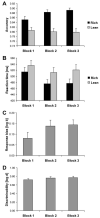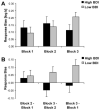Toward an objective characterization of an anhedonic phenotype: a signal-detection approach
- PMID: 15705346
- PMCID: PMC2447922
- DOI: 10.1016/j.biopsych.2004.11.026
Toward an objective characterization of an anhedonic phenotype: a signal-detection approach
Abstract
Background: Difficulties in defining and characterizing phenotypes has hindered progress in psychiatric genetics and clinical neuroscience. Decreased approach-related behavior and anhedonia (lack of responsiveness to pleasure) are considered cardinal features of depression, but few studies have used laboratory-based measures to objectively characterize these constructs.
Methods: To assess hedonic capacity in relation to depressive, particularly anhedonic, symptoms, 62 participants completed a signal-detection task based on a differential reinforcement schedule. Anhedonia was operationalized as decreased reward responsiveness.
Results: Unequal frequency of reward between two correct responses produced a response bias (i.e., a systematic preference to identify the stimulus paired with the more frequent reward). Subjects with elevated depressive symptoms (Beck Depression Inventory scores >/= 16) failed to show a response bias. Impaired reward responsiveness predicted higher anhedonic symptoms 1 month later, after controlling for general negative affectivity.
Conclusions: Impaired tendency to modulate behavior as a function of prior reinforcement might underline diminished hedonic capacity in depression. When applied to a clinical population, objective assessments of participants' propensity to modulate behavior as a function of reward might provide a powerful tool for improving the phenotypic definition of depression and thus offer a reliable behavioral screening approach for neuroscience studies of depression.
Figures





References
-
- American Psychiatric Association . Diagnostic and Statistical Manual of Mental Disorders. 4th ed. American Psychiatric Press; Washington, D.C.: 1994.
-
- Beck AT, Steer RA, Garbin M. Psychometric proprieties of the Beck Depression Inventory; 25 years of evaluation. Clin Psychol Rev. 1988;8:77–100.
-
- Beck AT, Steer RA, Brown GK. Beck Depression Inventory Manual. 2nd ed. The Psychological Corporation; San Antonio, TX: 1996.
-
- Bruder GE, Towey JP, Stewart JW, Friedman D, Tenke C, Quitkin FM. Event-related potentials in depression: Influence of task, stimulus hemifield and clinical features on P3 latency. Biol Psychiatry. 1991;30:233–246. - PubMed
Publication types
MeSH terms
Grants and funding
LinkOut - more resources
Full Text Sources
Other Literature Sources

